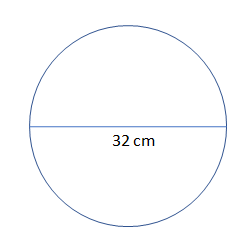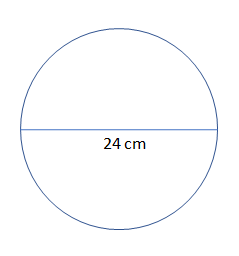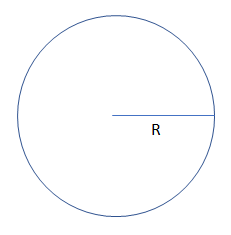
The diameters of the two circles are 32 cm and 24 cm. Find the radius of the circle having its area equal to the sum of the areas of two given circles.
Answer
478.8k+ views
Hint: First, before proceeding for this, we must draw the two circles with diameters as 32 cm and 24 cm to get a clear picture of the new circle radius Then, , by using the concept of property of the circle which states that radius of the circle is half of the diameter, we get the radius of both circles. Then, by using the condition given in the question as the new circle area A is the summation of two given circles areas ${{A}_{1}}$and ${{A}_{2}}$, we get the required radius of the new circle.
Complete step by step answer:
In this question, we are supposed to find the radius of the circle having its area equal to the sum of the areas of two circles with diameters 32 cm and 24 cm.
So, before proceeding for this, we must draw the two circles with diameters as 32 cm and 24 cm to get a clear picture of the new circle radius required as:


Then, by using the concept of property of the circle which states that radius of the circle is half of the diameter.
So, by using this property, we get the radius ${{r}_{1}}$of big circle as:
$\begin{align}
& {{r}_{1}}=\dfrac{32}{2} \\
& \Rightarrow {{r}_{1}}=16cm \\
\end{align}$
Similarly, by using the same property, we get the radius ${{r}_{2}}$of small circle as:
$\begin{align}
& {{r}_{2}}=\dfrac{24}{2} \\
& \Rightarrow {{r}_{1}}=12cm \\
\end{align}$
Now, let us suppose that the area of the circle which is required and given as the summation of the area of above two circles has the radius R.

So, by using the condition given in the question as the new circle area A is the summation of two given circles areas ${{A}_{1}}$and ${{A}_{2}}$ as:
$A={{A}_{1}}+{{A}_{2}}$
Then, by substituting the value of the area of both the given circles and new circle as:
$\begin{align}
& \pi {{R}^{2}}=\pi {{r}_{1}}^{2}+\pi {{r}_{2}}^{2} \\
& \Rightarrow {{R}^{2}}={{r}_{1}}^{2}+{{r}_{2}}^{2} \\
\end{align}$
Then, by substituting the value of ${{r}_{1}}$and ${{r}_{2}}$, we get the value of R as:
$\begin{align}
& {{R}^{2}}={{\left( 16 \right)}^{2}}+{{\left( 12 \right)}^{2}} \\
& \Rightarrow {{R}^{2}}=196+144 \\
& \Rightarrow {{R}^{2}}=340 \\
& \Rightarrow R=\sqrt{340} \\
& \Rightarrow R=2\sqrt{85}cm \\
\end{align}$
Hence, we get the radius of the new circle as $2\sqrt{85}cm$.
Note: Now, to solve these types of questions we need to know some of the basic formulas beforehand so that we can easily proceed in these types of questions. Then, some of the basic formulas related to circle are:
Area of the circle is given by $A=\pi {{r}^{2}}$ and the diameter of the circle is twice the radius of the circle.
Complete step by step answer:
In this question, we are supposed to find the radius of the circle having its area equal to the sum of the areas of two circles with diameters 32 cm and 24 cm.
So, before proceeding for this, we must draw the two circles with diameters as 32 cm and 24 cm to get a clear picture of the new circle radius required as:


Then, by using the concept of property of the circle which states that radius of the circle is half of the diameter.
So, by using this property, we get the radius ${{r}_{1}}$of big circle as:
$\begin{align}
& {{r}_{1}}=\dfrac{32}{2} \\
& \Rightarrow {{r}_{1}}=16cm \\
\end{align}$
Similarly, by using the same property, we get the radius ${{r}_{2}}$of small circle as:
$\begin{align}
& {{r}_{2}}=\dfrac{24}{2} \\
& \Rightarrow {{r}_{1}}=12cm \\
\end{align}$
Now, let us suppose that the area of the circle which is required and given as the summation of the area of above two circles has the radius R.

So, by using the condition given in the question as the new circle area A is the summation of two given circles areas ${{A}_{1}}$and ${{A}_{2}}$ as:
$A={{A}_{1}}+{{A}_{2}}$
Then, by substituting the value of the area of both the given circles and new circle as:
$\begin{align}
& \pi {{R}^{2}}=\pi {{r}_{1}}^{2}+\pi {{r}_{2}}^{2} \\
& \Rightarrow {{R}^{2}}={{r}_{1}}^{2}+{{r}_{2}}^{2} \\
\end{align}$
Then, by substituting the value of ${{r}_{1}}$and ${{r}_{2}}$, we get the value of R as:
$\begin{align}
& {{R}^{2}}={{\left( 16 \right)}^{2}}+{{\left( 12 \right)}^{2}} \\
& \Rightarrow {{R}^{2}}=196+144 \\
& \Rightarrow {{R}^{2}}=340 \\
& \Rightarrow R=\sqrt{340} \\
& \Rightarrow R=2\sqrt{85}cm \\
\end{align}$
Hence, we get the radius of the new circle as $2\sqrt{85}cm$.
Note: Now, to solve these types of questions we need to know some of the basic formulas beforehand so that we can easily proceed in these types of questions. Then, some of the basic formulas related to circle are:
Area of the circle is given by $A=\pi {{r}^{2}}$ and the diameter of the circle is twice the radius of the circle.
Recently Updated Pages
Questions & Answers - Ask your doubts

Master Class 11 Accountancy: Engaging Questions & Answers for Success

Master Class 11 Science: Engaging Questions & Answers for Success

Full Form of IASDMIPSIFSIRSPOLICE class 7 social science CBSE

In case of conflict between fundamental rights of citizens class 7 social science CBSE

Can anyone list 10 advantages and disadvantages of friction

Trending doubts
The Equation xxx + 2 is Satisfied when x is Equal to Class 10 Maths

Why is there a time difference of about 5 hours between class 10 social science CBSE

Who was Subhash Chandra Bose Why was he called Net class 10 english CBSE

Change the following sentences into negative and interrogative class 10 english CBSE

Write a letter to the principal requesting him to grant class 10 english CBSE

Explain the Treaty of Vienna of 1815 class 10 social science CBSE




